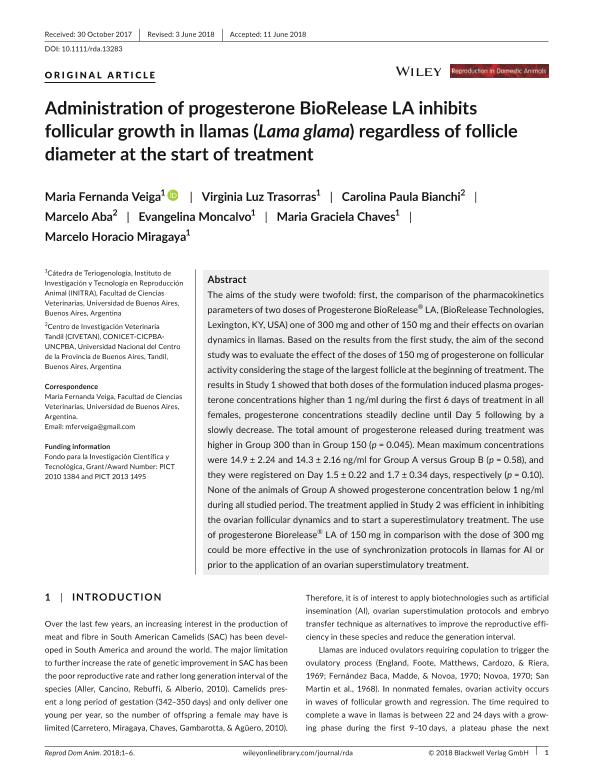Mostrar el registro sencillo del ítem
dc.contributor.author
Veiga, Maria Fernanda

dc.contributor.author
Trasorras, Virginia Luz

dc.contributor.author
Bianchi, Carolina Paula

dc.contributor.author
Aba, Marcelo Alfredo

dc.contributor.author
Moncalvo, Carla Evangelina

dc.contributor.author
Chaves, María Graciela

dc.contributor.author
Miragaya, Marcelo Horacio
dc.date.available
2019-11-14T17:37:23Z
dc.date.issued
2018-12
dc.identifier.citation
Veiga, Maria Fernanda; Trasorras, Virginia Luz; Bianchi, Carolina Paula; Aba, Marcelo Alfredo; Moncalvo, Carla Evangelina; et al.; Administration of progesterone BioRelease LA inhibits follicular growth in llamas (Lama glama) regardless of follicle diameter at the start of treatment; Wiley Blackwell Publishing, Inc; Reproduction in Domestic Animals; 53; 6; 12-2018; 1347-1352
dc.identifier.issn
0936-6768
dc.identifier.uri
http://hdl.handle.net/11336/88883
dc.description.abstract
The aims of the study were twofold: first, the comparison of the pharmacokinetics parameters of two doses of Progesterone BioRelease® LA, (BioRelease Technologies, Lexington, KY, USA) one of 300 mg and other of 150 mg and their effects on ovarian dynamics in llamas. Based on the results from the first study, the aim of the second study was to evaluate the effect of the doses of 150 mg of progesterone on follicular activity considering the stage of the largest follicle at the beginning of treatment. The results in Study 1 showed that both doses of the formulation induced plasma progesterone concentrations higher than 1 ng/ml during the first 6 days of treatment in all females, progesterone concentrations steadily decline until Day 5 following by a slowly decrease. The total amount of progesterone released during treatment was higher in Group 300 than in Group 150 (p = 0.045). Mean maximum concentrations were 14.9 ± 2.24 and 14.3 ± 2.16 ng/ml for Group A versus Group B (p = 0.58), and they were registered on Day 1.5 ± 0.22 and 1.7 ± 0.34 days, respectively (p = 0.10). None of the animals of Group A showed progesterone concentration below 1 ng/ml during all studied period. The treatment applied in Study 2 was efficient in inhibiting the ovarian follicular dynamics and to start a superestimulatory treatment. The use of progesterone Biorelease® LA of 150 mg in comparison with the dose of 300 mg could be more effective in the use of synchronization protocols in llamas for AI or prior to the application of an ovarian superstimulatory treatment.
dc.format
application/pdf
dc.language.iso
eng
dc.publisher
Wiley Blackwell Publishing, Inc

dc.rights
info:eu-repo/semantics/openAccess
dc.rights.uri
https://creativecommons.org/licenses/by-nc-sa/2.5/ar/
dc.subject
PROGESTERONE
dc.subject
FOLLICULAR GROWTH
dc.subject
LLAMAS
dc.subject.classification
Ciencias Veterinarias

dc.subject.classification
Ciencias Veterinarias

dc.subject.classification
CIENCIAS AGRÍCOLAS

dc.title
Administration of progesterone BioRelease LA inhibits follicular growth in llamas (Lama glama) regardless of follicle diameter at the start of treatment
dc.type
info:eu-repo/semantics/article
dc.type
info:ar-repo/semantics/artículo
dc.type
info:eu-repo/semantics/publishedVersion
dc.date.updated
2019-10-23T21:35:34Z
dc.identifier.eissn
1439-0531
dc.journal.volume
53
dc.journal.number
6
dc.journal.pagination
1347-1352
dc.journal.pais
Reino Unido

dc.journal.ciudad
Londres
dc.description.fil
Fil: Veiga, Maria Fernanda. Universidad de Buenos Aires. Facultad de Ciencias Veterinarias. Instituto de Investigacion y Tecnología en Reproducción Animal; Argentina
dc.description.fil
Fil: Trasorras, Virginia Luz. Universidad de Buenos Aires. Facultad de Ciencias Veterinarias. Instituto de Investigacion y Tecnología en Reproducción Animal; Argentina. Consejo Nacional de Investigaciones Científicas y Técnicas; Argentina
dc.description.fil
Fil: Bianchi, Carolina Paula. Universidad Nacional del Centro de la Provincia de Buenos Aires; Argentina. Consejo Nacional de Investigaciones Científicas y Técnicas. Centro Científico Tecnológico Conicet - Tandil. Centro de Investigación Veterinaria de Tandil. Universidad Nacional del Centro de la Provincia de Buenos Aires. Centro de Investigación Veterinaria de Tandil. Provincia de Buenos Aires. Gobernación. Comision de Investigaciones Científicas. Centro de Investigación Veterinaria de Tandil; Argentina
dc.description.fil
Fil: Aba, Marcelo Alfredo. Consejo Nacional de Investigaciones Científicas y Técnicas. Centro Científico Tecnológico Conicet - Tandil. Centro de Investigación Veterinaria de Tandil. Universidad Nacional del Centro de la Provincia de Buenos Aires. Centro de Investigación Veterinaria de Tandil. Provincia de Buenos Aires. Gobernación. Comision de Investigaciones Científicas. Centro de Investigación Veterinaria de Tandil; Argentina
dc.description.fil
Fil: Moncalvo, Carla Evangelina. Universidad de Buenos Aires. Facultad de Ciencias Veterinarias. Instituto de Investigacion y Tecnología en Reproducción Animal; Argentina
dc.description.fil
Fil: Chaves, María Graciela. Universidad de Buenos Aires. Facultad de Ciencias Veterinarias. Instituto de Investigacion y Tecnología en Reproducción Animal; Argentina
dc.description.fil
Fil: Miragaya, Marcelo Horacio. Universidad de Buenos Aires. Facultad de Ciencias Veterinarias. Instituto de Investigacion y Tecnología en Reproducción Animal; Argentina
dc.journal.title
Reproduction in Domestic Animals

dc.relation.alternativeid
info:eu-repo/semantics/altIdentifier/url/https://onlinelibrary.wiley.com/doi/abs/10.1111/rda.13283
dc.relation.alternativeid
info:eu-repo/semantics/altIdentifier/doi/http://dx.doi.org/10.1111/rda.13283
Archivos asociados
